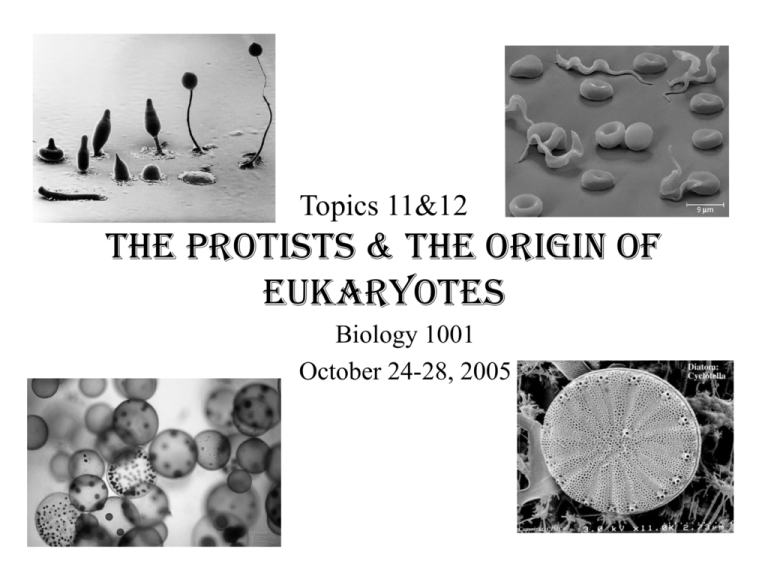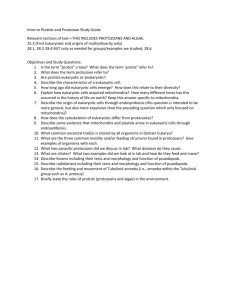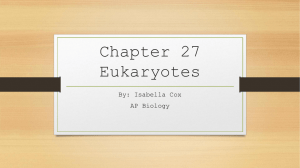Topics 11&12 The Protists & the Origin of Eukaryotes
advertisement

Topics 11&12 The Protists & the Origin of Eukaryotes Biology 1001 October 24-28, 2005 11.1 Introduction to the Protists Protists is the informal name given to a diverse collection of mostly unicellular (some colonial or multicellular) eukaryotes Protists are exceedingly complex at the cellular level, and exhibit more structural and functional diversity than any other group of organisms Formerly the Kingdom Protista in the 5K system of classification, now about 20 different kingdoms in the Domain Eukarya The different lineages of protists are not a monophyletic group; in fact some protists are more closely related to plants, animals or fungi than they are to other protists A Tentative Phylogeny of the Eukaryotes A Sampling of Protistan Diversity Giardia intestinalis, a diplomonad Euglena acus, a euglenid Trichomonas vaginalis, a parabasalid Trypanosoma sp., a kinetoplastid Pfiesteria shumwayae, a dinoflagellate Paramecium sp., a ciliate Diatoms A radiolarian Kelp, giant brown algae seaweeds Amoeba sp., a gymnamoeba Physarum polychalum, a slime mold The Functional & Structural Diversity of Protists Nutrition Protists can be photoautotrophic, chemoheterotrophic, or mixotrophic Mode of nutrition not phylogenetically informative but ecologically useful Ingestive heterotrophs (animal-like) = protozoa Absorptive heterotrophs (fungus-like) = no general name Autotrophs (plant-like) = algae Habitat Most are aquatic, preferring moist environments Are important constituents of plankton Seas, ponds, lakes, moist soil, the human body… Phytoplankton contains algae and cyanobacteria Many protists are symbiotic and some are parasitic/pathogenic Life Cycle Some are strictly asexual Others can also reproduce sexually (meiosis & fertilization) All three basic types of sexual life cycle are employed1 12.0 Examples of Autotrophic Protists 12.1 Euglena sp. Members of the Euglenid group of the clade Euglenozoa Characterized by an anterior pocket from which one or two flagella emerge, and the storage polysaccharide paramylon The eyespot functions as a light shield allowing only certain light rays to strike the light detector The pellicle is constructed of protein bands beneath the plasma membrane and provides strength and flexibility Figure 28.8 More about Euglena sp. Nutrition Euglena are mixotrophic – Perform photosynthesis in the light Lose chlorophyll in the dark & absorb organic molecules via the plasma membrane Locomotion Locomotion is either swimming (flagellar motion), gliding, or euglenoid movement1 Euglena exhibit positive phototaxis – the light detector senses light, the flagellum propels the Euglena toward it Osmoregulation Euglena are hypertonic to their freshwater environment Water enters by osmosis and needs to be removed The contractile vacuole fills with water and then fuses with the gullet to release it 12.0 Examples of Autotrophic Protists 12.2 Laminaria sp. A brown algae species of the Stramenopila clade, characterized by “hairy flagella” (only flagellated stage is a motile reproductive cell) A seaweed - a large, complex, multicellular, marine alga The thallus body consists of a rootlike holdfast, a stemlike stipe, and leaflike blades More about Laminaria sp. Exhibits a life cycle called alternation of generations1 Two multicellular stages that differ in ploidy The sporophyte is diploid; the gametophyte is haploid The gametophyte produces haploid gametes by mitosis The gametes unite by fertilization to form a zygote that develops into a sporophyte The sporophyte produces haploid spores by meiosis The spores grow up into male or female gametophytes The main form is the sporophyte, the gametophytes are short, branched filaments – the two generations are heteromorphic Figure 28.21 Eukaryotic CellS Topics 11.2-11.6 The cells of all protists, plants, animals, and fungi Eukaryotic cells are structurally more complex and larger than prokaryotic cells They have a true membrane-bound nucleus and other membrane bound organelles Metabolic requirements impose theoretical lower and upper limits on cell size1 Eukaryotic cells are 10-100 µm and the smallest bacteria are 0.1-1 µm Fig. 6.7 Exploring Plant and Animal Cells Figure 6.9 • Eukaryote cells have extensively and elaborately arranged internal membranes that divide the cell into compartments and house enzymes for various metabolic functions Components of the Eukaryotic Cell The nucleus and its envelope, Figure 6.10 The nucleus contains the chromosomes, made of chromatin (DNA & proteins) The nuclear envelope is a double membrane (two phospholipid bilayers with associated proteins) perforated by pores A prominent structure in the nucleus is the nucleolus where the ribosomal subunits are assembled The Endomembrane System A network of membranes with diverse functions, connected to each other physically or by vesicles Contains the nuclear envelope, endoplasmic reticulum, Golgi apparatus, lysosomes, various vacuoles, and the plasma membrane A lysosome is a membranous sac of hydrolytic enzymes that an animal cell uses to digest all kinds of macromolecules Mature plant cells have a large central vacuole enclosed by a membrane called the tonoplast. This vacuole has numerous functions: it stores nutrients and defense compounds, acts as a disposal site for metabolic wastes, increases the membrane available to the cytosol, and enables the cell to increase in size by taking in water. The Endoplasmic Reticulum Figure 6.12 The ER is an extensive network of membranes that accounts for half of the total membrane in a cell A network of membranous tubules and sacs called cisternae, it has an interior lumen continuous with the gap between the two membranes of the nuclear envelope ER can be smooth or rough (studded with ribosomes). Smooth ER functions include synthesis of lipids, metabolism of carbohydrates, and detoxification Rough ER is involved in the synthesis of proteins that are destined for secretion, and also the synthesis of new membrane The Golgi Apparatus Figure 6.13 A series of flattened membranous sacs called cisternae The Golgi receives products from the ER, modifies and sorts them, and transports them to other parts of the cell It also synthesizes macromolecules such as polysaccharides Products are received from the ER at the cis face of the Golgi, and transported away from the trans face, in transport vesicles Mitochondria & Chloroplasts Mitochondria and chloroplasts are the energy transformers of the eukaryotic cell Mitochondria, present in all eukaryotes, are the sites of cellular respiration, where ATP is generated using energy from the anabolism of macromolecules – C6H12O6 + O2 CO2 + H2O + energy Chloroplasts, present only in plants and algae, are the sites of photosynthesis, where solar energy is converted to chemical energy in the form of macromolecules - CO2 + H2O + energy C6H12O6 + O2 Although membrane-bound, neither mitochondria nor chloroplasts are part of the endomembrane system Each of these organelles has its own ribosomes and DNA Figure 6.17 – The mitochondrion, site of cellular respiration Figure 6.18 – The chloroplast, site of photosynthesis Other Differences Between Prokaryotes and Eukaryotes Type of cell division: binary fission in prokaryotes, meiosis or mitosis in eukaryotes Many linear chromosomes instead of one circular one Presence of a cytoskeleton to support the cell, maintain its shape, transport vesicles and chromosomes around the cell, and give the cell motility The cytoskeleton consists of three types of subunits, microtubules, microfilaments, and intermediate filaments, each with several functions 11.7 The Origin of Eukaryotes The first eukaryotes were predators: the cytoskeleton allows a eukaryotic cell to engulf other cells The endosymbiosis theory explains how complex eukaryotic cells likely arose from a prokaryotic ancestor The theory proposes that mitochondria and plastids (chloroplasts and related organelles) were formerly small prokaryotes called endosymbionts living within larger host cells An aerobic heterotrophic alpha proteobacteria was the mitochondrial ancestor, and a gram negative cyanobacteria was the chloroplast ancestor Serial endosymbiosis accounts for the fact that all eukaryotes have mitochondria, but only some have chloroplasts Figure 26.13 Endosymbiosis in Eukaryote Evolution The evidence for endosymbiosis is overwhelming Mitochondria and chloroplasts have their own DNA and ribosomes, and their ribosomes are more similar to prokaryotes They reproduce by binary fission They have enzymes similar to prokaryotes Secondary endosymbiosis accounts for some of the diversity of protists Red and green algae are thought to have been engulfed in the past by other eukaryotes, leading to some of the contemporary protistan forms Figure 28.3 Secondary Endosymbiosis







